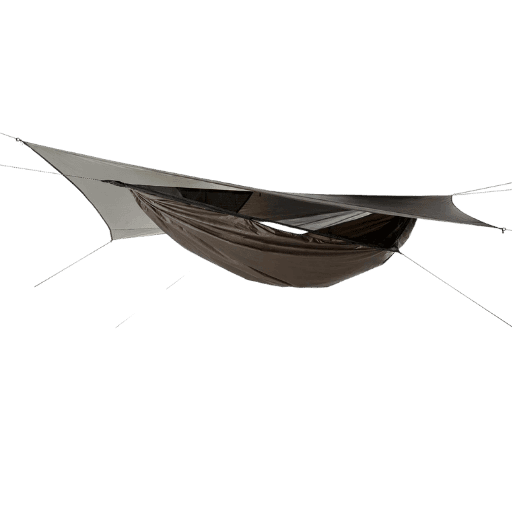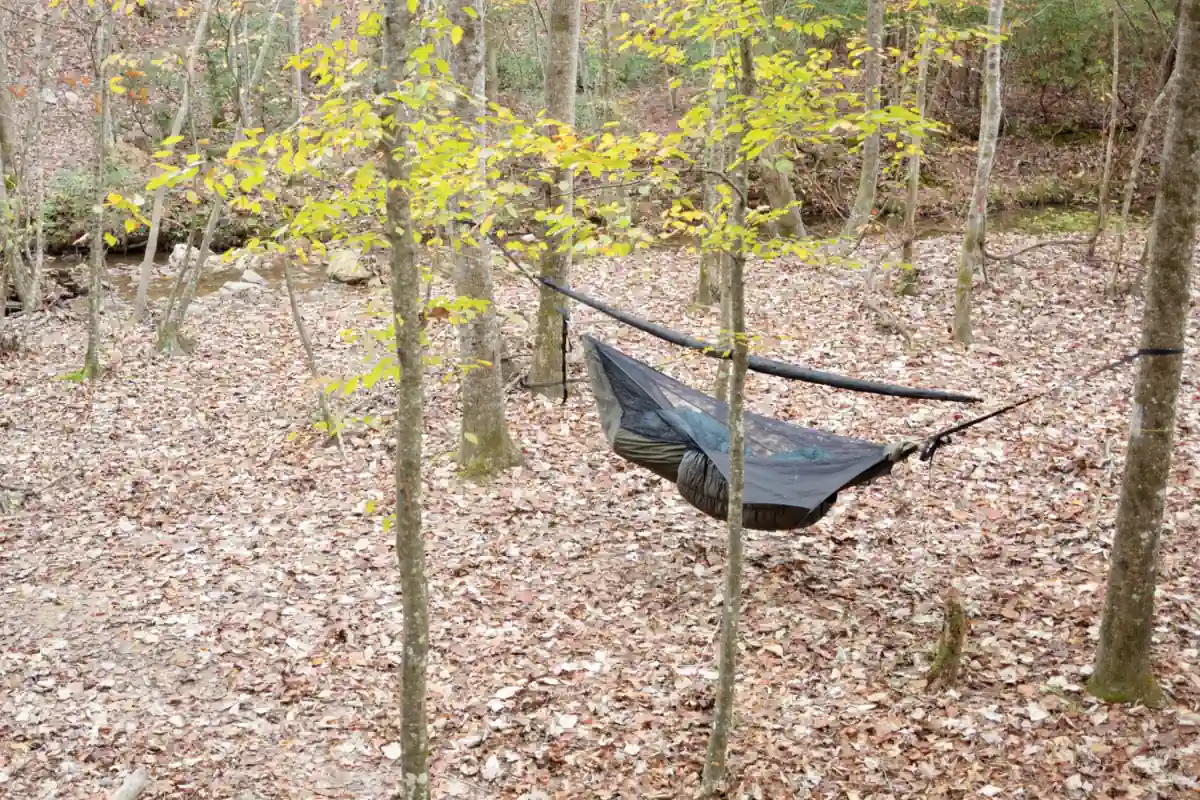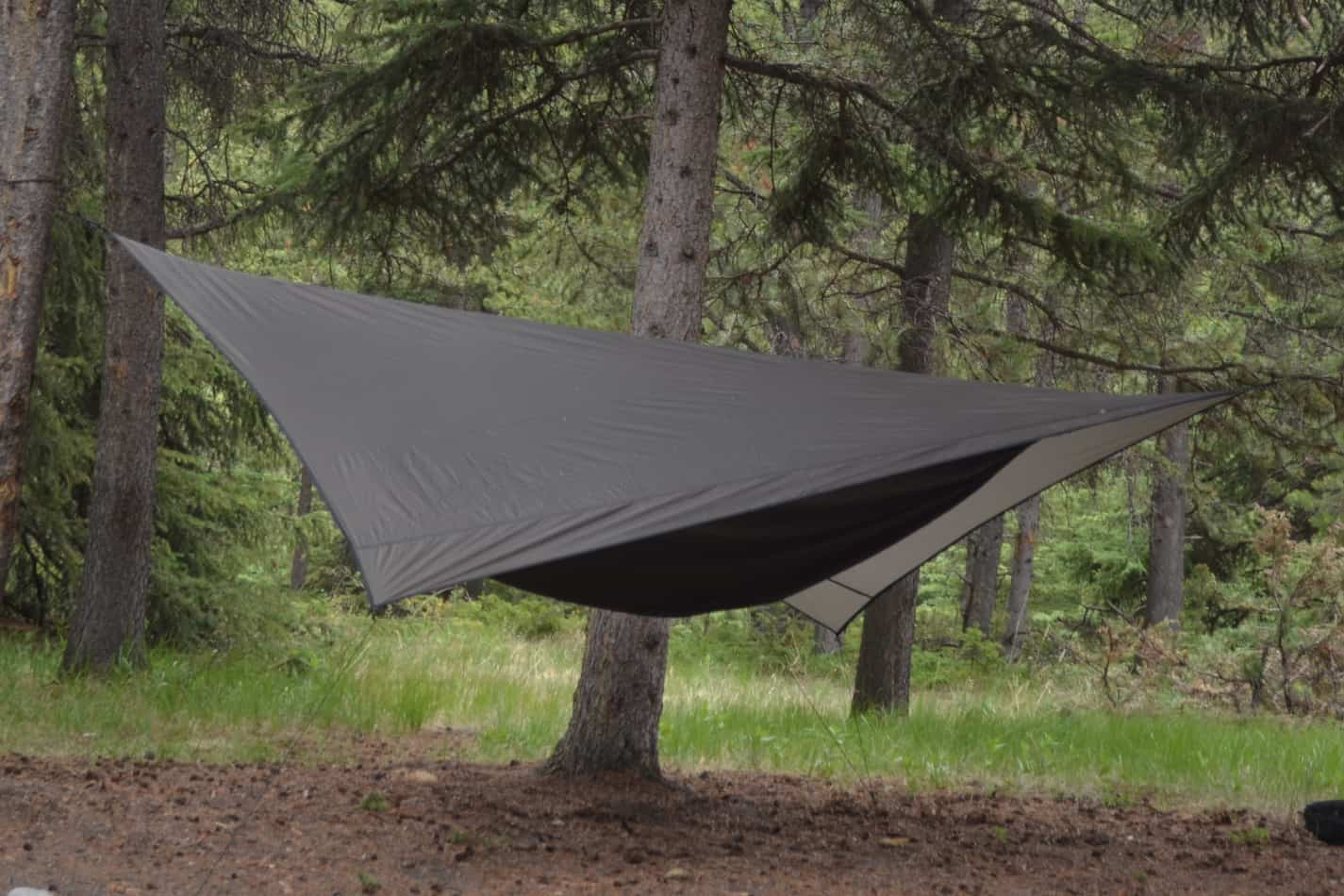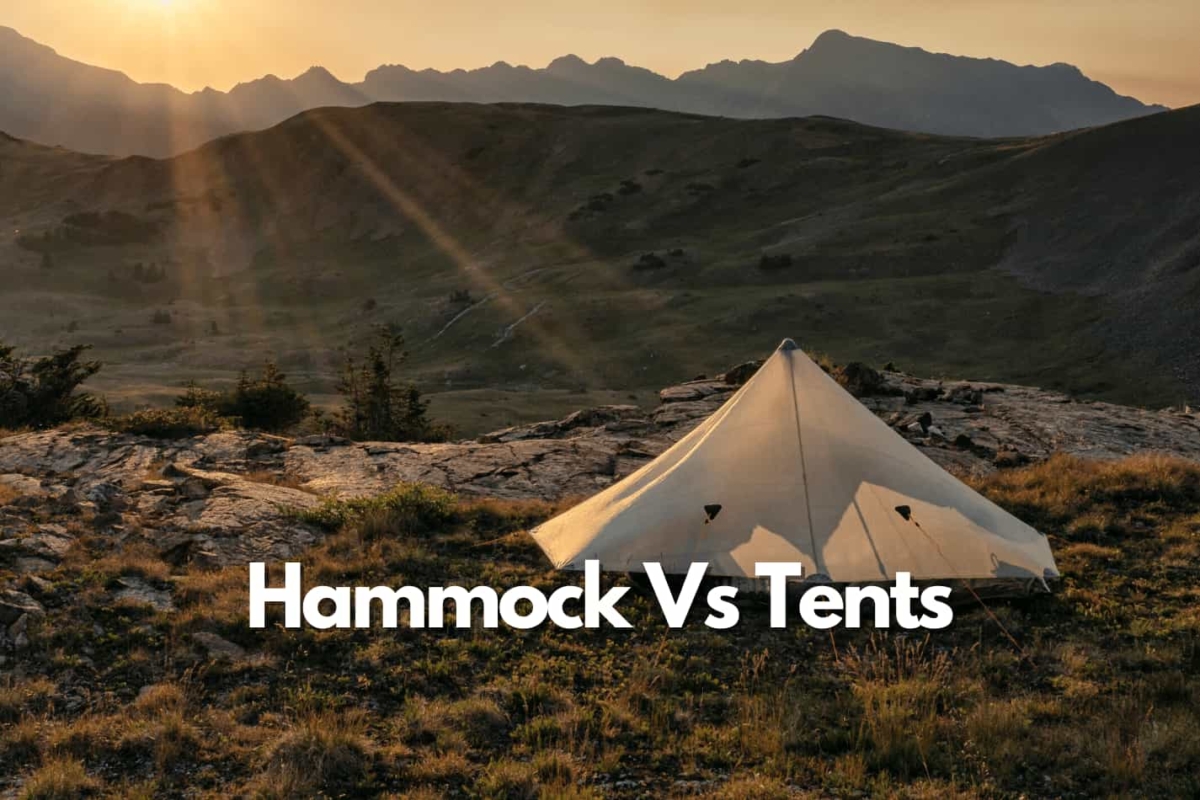A colossal discussion that wages on forever are in the choice of shelter you choose to use for a thru-hike. For some, a tent will always win, but hammocks are unbeatable for a group that now includes me.
Let’s look more into choosing a hammock vs a tent and see which one comes out on top for you.
Are you a hammock or tent person?
Comparing Hammocks and Tents for Camping
While nearly everyone is familiar with both hammocks and tents, most have a solid understanding of only tents. They are more aware of how you assemble and pitch tents also. You almost instinctually know what’s required for space and comfort.
On the other hand, hammocks are a bit more mysterious for those new to hanging. I know because I felt the same before diving into the fold with my Hummingbird Long lightweight hammock camping setup.
You might wonder how you could sleep in something that dangles from two trees and doesn’t even have a floor, but let me tell you. I get fantastic sleep in a hammock. I may state that I have never slept better, maybe better than my home bed!
But once you get used to them, hammocks may provide an extremely versatile system for camping and backpacking while giving you the lightweight and ultra-comfortable rest you’ve requested.

The Benefits of Tent Camping
There are a tremendous amount of good things behind a tent, which is why they continue to be the overall favorite for a majority of hikers overall.
Let’s discuss the main points behind a tent as a shelter for a thru-hike and help you think more deeply about your decision.
Practicality
Tents are convenient in the wide world of camping and backpacking. They provide security against bad weather and pests while giving you a comfortable place to rest your head at night.
Many types of tents on the market can accommodate any need, from a super small and ultra-lightweight one-person to a super spacious luxury two-person home.
There’s a tent for everyone, and they’re relatively easy to set up.
Comfort
Most have a long history of setting them up, leading to a comfort level that can’t be found elsewhere.
You know precisely how your tent will act in high winds and how to set up the rain fly and tent stakes to work best for you, making it a comfortable and safe space to hunker down during a storm.
Protection
Tents offer what most look for while out in the wild: four walls and a ceiling, much like a home would provide them.
This protects you from the elements, whether rain, snow, wind or the sun. It also offers a barrier against pests and animals that might want to harm you or steal your food.
Whether this is imaginary protection is not a big concern; it is just the belief in protection that matters most.
Options
Tents have a wide variety of options available on the market, giving you a lot of choices when it comes to finding the perfect one for your needs.
You can find tents with different materials, weights, and sizes that all fit your preferences.
Size and Weight
Tents come in a massive range of sizes and weights, which allows them to fit nearly any need for someone on a trail. The cream of the crop for thru-hiking is DCF, which is amazingly durable and ultralight weight.
Tents can be as small and light as one person needs them to be or large enough for two or even a family, allowing you to hike with whoever you want without worrying about weight as you can always split it if needed.
Set up
Most know how tents are set up, from tent poles to trekking poles. The setup, in general, is pretty simple and easy to do.
Part of the setup is the area of space needed. For those who use tents, this almost comes naturally without much thought, meaning you know at a glance if you can fit your tent.
Limitations
Tents come with some limits, like needing flat open ground that might not always be available.
You also weigh the tent to consider, which can get hefty very quickly if you want a larger one.
Price
Tents can range from $100 to $700 or more, giving you a considerable range in performance and weight depending on the amount you can invest.
The less the cost, the more they will tend to weigh, so considering this for a six-month thru-hike is vitally important.

The Benefits of Hammock Camping
Now, hammocks are not the be-all and end-all of camping or backpacking shelters, but they have been on the rise for many years for a good reason.
Let’s discuss them in more detail to directly compare them to the tent details above.
Comfort
Not much can rival the comfort a hammock will provide you on the trail. With the diagonal lay, you will be nearly flat, leading to some of the most restful sleep you will ever have.
This is due to the hammock’s ability to evenly distribute your weight and take the pressure off your spine and other joints.
Protection
Hammocks are raised off the ground, protecting you from wandering critters and pests that might want to bother you at night.
The hammock will also protect you from the ground if it is wet, keeping you dry and comfortable all night long.
The tarp will protect you from elements like heavy rains or snow.
Options
Hammocks are massively built with hammock accessories and options for upgrading or replacing nearly any specific items from various companies.
You can find ultralight hammocks and some with extra features like mosquito nets and storage pockets.
Then there are the lines and hardware to hold your hammock off the ground, and there are infinite options for a hammock system.
Size and Weight
Hammock systems have difficulty getting to the same lightness as tents but are almost always smaller in a pack due to their modularity.
There are crazy ultralight materials that weigh nearly nothing and look like mosquito netting that is dropping serious weight; these new fabrics and techniques are constantly being developed.
Set up
The hammock will take some time to get used to, but it is a breeze once you have it down.
You must find two trees the correct distance apart and have a good, sturdy hold. Then, rig your hammock using whoopie slings, continuous loops, or webbing straps.
Once the hammock is off the ground, you can enter it and lie in your desired position.
Most hammocks will come with a tarp that will protect you from rain or snow and can be easily set up using guy lines and trees.
Limitations
Hammocks have a few limitations to think about before you decide to make the switch. First, you need two trees close to the hammock, which isn’t always possible.
Another issue is that you are more exposed in a hammock than in a tent so inclement weather can be an issue.
Price
Hammocks are typically equal to tents in many respects to price. Most of the time, they are more expensive, though they need items like underquilts, which are more expensive than a similar foam sleeping pad or inflatable.
They can also last longer if you take care of them as they aren’t exposed to the ground and rocks and damage, so the initial investment might sting a little more but will be worth it in the long run.

Key Advantages of Tents vs Hammocks
Now we can look at the pros and cons of a tent vs hammock regarding thru-hiking and see where each one might have its advantages for the hiker.
Pros to Tents
There are many benefits to using a tent for a thru-hike over a hammock:
Simpler to Find a Camp Spot
Most know how to look and see space on the ground and know if they can fit; then, you need to focus on if the ground is pretty flat and not too slanted.
Tent Campsites are More Established
There will usually be a designated tent campsite with a fire ring and maybe some flat spots to put your tent. This means you don’t need to clear as much space and can just focus on your hammock.
More Protective From the Elements
With complete coverage of material all around you, tents will provide better protection in bad weather than hammocks.
This is due to being lower to the ground and having more walls/ceilings to block wind, rain, and snow.
Vestibules For Storage Under Cover
A vestibule provides you with a space where you can store gear without bringing it into the tent. When muddy and tired, this can be a godsend allowing you to leave it outside but protected.
Pros to Hammocks
Some benefits of hammocks are that:
Better Quality Rest and Recovery
Hammocks will provide a more comfortable night’s sleep in almost every situation. The main reason is that you aren’t lying on the rugged and unforgiving ground.
The hanging nature of hammocks takes all the pressure off your joints and allows you to sleep in positions that would be difficult or impossible on the ground.
Hammocks frequently help elevate legs after long days of hiking, which helps the blood drain easier and helps recover and be more ready for the next day of hiking.
More Views and Fewer Bugs
You are off the ground when hammocking, which has a few advantages. The first is that you will have an unobstructed view in every direction.
The second is that being off the ground means fewer bugs will bother you as they will be down on the ground where you aren’t.
You Can Hammock Almost Anywhere
As long as there are trees, you can have a hammock. This means you can hammock in places where pitching a tent would be difficult or impossible, like on a cliff or even over a stream.
A hammock also allows you to take advantage of impromptu campsites that pop up during the day’s hike without having to backtrack to find a suitable spot for your tent.
Can Be Suspended Above Terrain Limitations
Where you need cleared spots for a tent, a hammock can be over the top of rocky ground or shrubbery, allowing more flexibility in camp for the night.

Key Limitations of Tents vs Hammocks
Now we can look at the limitations of both tents and hammocks regarding a thru-hike and see where each one might have its disadvantages for the adventurous thru-hiker.
Drawbacks to Tents
There are many limitations to using a tent for a thru-hike over a hammock:
Tents are More Expensive
Generally, you will pay more for a similar hammock setup for the tent. When you factor in the weight and bulk of a tent, it can add up to be 2-3 times as expensive.
Tents are Heavier and Take Up More Room
The average hammock weighs between 18-30 ounces, while the average tent weighs between two and four pounds. This is a considerable difference when you carry everything on your back.
Tents are Bulkier
Many hammocks can be packed down small enough to fit in the palm of your hand, while even the smallest tents take up space comparable to a loaf of bread.
This difference can be significant when trying to save space in your pack.
Tent Campsites are Less Private
The nature of tent camping and tent campsites in general means there will be more people, leading to less privacy if you want to get away from it all unless you stealth camp.
You Need a Level Spot to Set Up a Tent
Tents need primarily level ground with a flat surface for the most comfort when resting. No one likes to slide and fall off their pads at night.
This can be difficult to find in many places and may lead you to hike further than you wanted to find a good spot to set up camp.
In addition, you need to ensure that you aren’t placing your tent on wet ground, as this can make you cooler and cause ground condensation within the tent.
Ground Quality Limiting Pitch Areas
Tents are hampered by rocky terrain and leave you scavenging any site for rocks, sticks, and other impactful items that can puncture holes in your tent body.
Managing tent spots is a sometimes frustrating chore at the end of the day when you are physically exhausted and want to relax.
Drawbacks to Hammocks
While tents have issues managing the ground, hammocks have difficulties with… Trees!
Need Proper Tree Distance
Understanding tree distance will take some time as anyone learning to hang a hammock will need to master this skill.
Unlike tents, you haven’t been looking for tree spacing your whole life so this skill can take some time to learn.
When the trees aren’t properly spaced, you can get an inefficient hang, leading to worse sleep and less comfort.
Improper Setup Can Damage Trees
If you use the wrong straps and set them up improperly, you can cause severe damage to the trees with improper hammock camping.
This is why most hammock companies have created one-inch and two-inch flat tree straps that help to distribute weight and have less chance of damaging the trees.
Some Locations Don’t Have Trees!
In the mountains, above the treeline, you will have to get creative with your hammock setup or use a tent.
The same goes for desert locations where hammocking isn’t possible due to a lack of trees.
Some Locations Restrict the Use
Some parks and other areas may not fully allow the use of hammocks due to damage done by others, which can frustrate a hammock camper.

Frequently Asked Questions
There are a few questions that come up often when discussing hammocks vs tents. Here are a few of the most popular ones:
Can I use a hammock in cold weather?
Yes, you can hammock in cold weather! There are many ways to insulate yourself from the cold air, including an underquilt, a sleeping pad, and a top quilt.
Can I use a hammock in the rain?
Yes, hammocks can be used in the rain, but you will need to use your rain tarp to stay dry. Ensure your hammock tarp is staked correctly and the ridgeline is taught so it can last the night without issue.
Can you sleep above unusable spaces?
Yes, hammocks allow you to sleep in areas that would be unusable for a tent, such as on top of a rocky surface.
Do hammocks take more time to set up?
This depends on the hammock camper. Some people can set up their hammock in less than two minutes, while it might take others ten minutes or more. It comes down to practice and hammock type.
Final Thoughts on Choosing a Hammock Vs Tent
So, which is the superior option for you? It depends on your specific requirements and preferences. A hammock is probably the best choice if you enjoy camping alone, as you can find campsites that aren’t tent-friendly.
If you don’t mind sharing your campsite with others, a tent could be just what you’re looking for as they are typically grouped in the open, level clearings.
Ultimately, the choice comes down to what you can be comfortable with for months. For most thru-hikers, this is a tent.
But if you have that wild hair in you as I do, then taking the hammock can help you get better rest and more miles each day without the same fatigue!


Leave a Comment